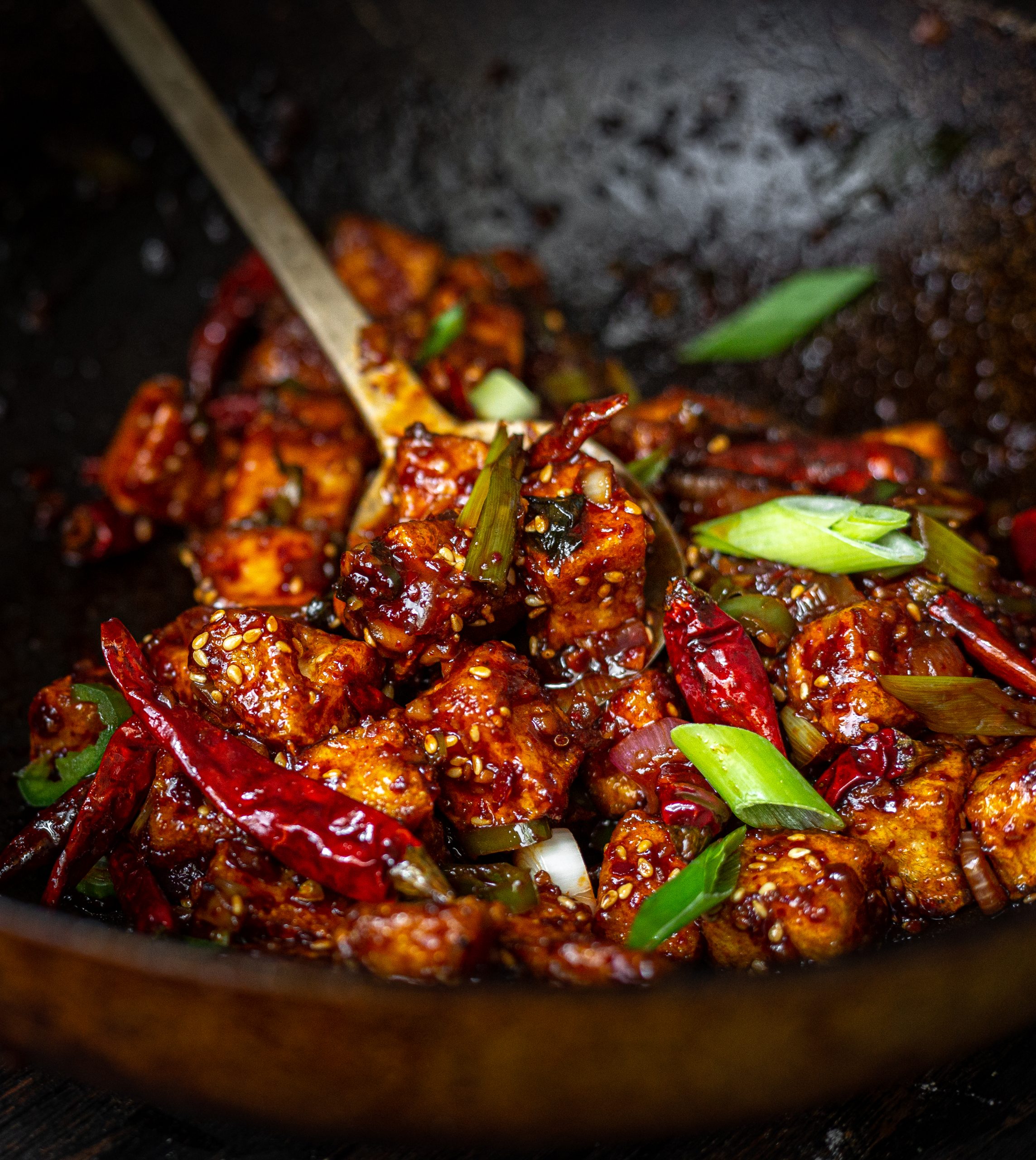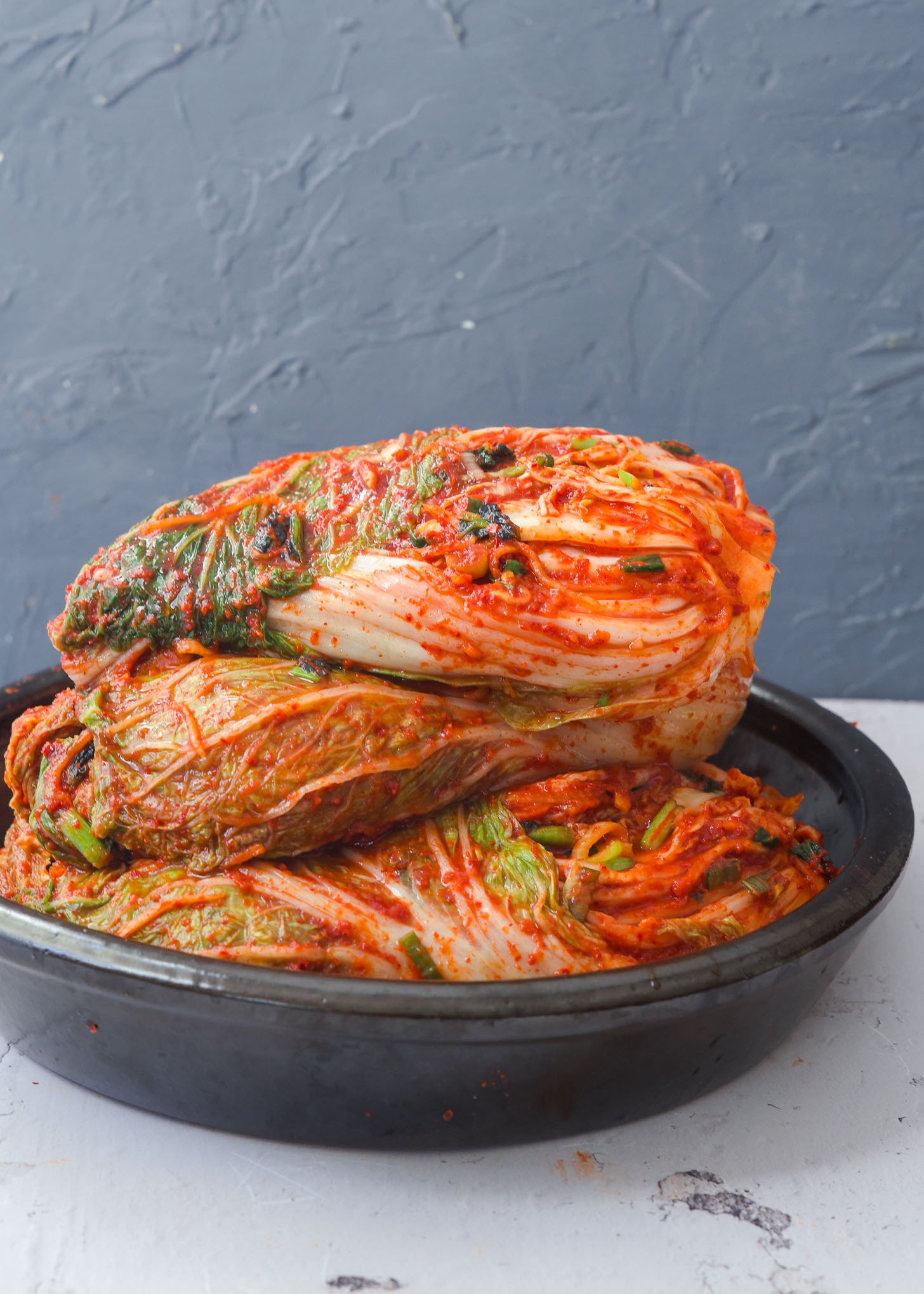
Cheesy.
Flavorful.
Delicious.
This vegan lasagna recipe is the product of years and years of practice, iteration, research, trial and error. If you have my cookbook, then you know that lasagna holds a special place in my heart! But man… It can be a labor of love! This scrumptious and easy vegan lasagna recipe manages to contain all the flavor of a phenomenal lasagna, but with half the work. I can therefore confidently say that this is truly the best vegan lasagna recipe I’ve ever tried, and I daresay it’ll soon become your go-to lasagna recipe too!
So, without further ado, let’s get into this amazing recipe!
Disclaimer: Some of the links in this post may be affiliate links for products I use and love. If you make a purchase after clicking one of those links, I may earn a small affiliate commission, perhaps enough to buy some extra gochujang or gochugaru 🙂
What Even is Lasagna?
Believe it or not, “lasagna” actually refers to the noodle–i.e., those flat, sheets you see sandwiched with ragu, cheese, and vegetables–and not the dish we’ve all come to know and love (i.e., the casserole). In fact, lasagna is one of the oldest pastas in Italian culture, possibly dating back to Ancient Roman times. Over the years, the term lasagna is used to describe both the pasta as well as the dish itself.
At bottom, lasagna (the dish) is a casserole, typically comprised of multiple layers of pasta, sauce, cheese, vegetables, and sometimes, some sort of meat. Obviously, this vegan lasagna won’t contain animal products, but I promise you, it’ll satisfy even the most die-hard meat eater!
It’s hard to describe what a “traditional lasagna recipe” would include, since what’s “traditional” depends so much on the region you’re in. For example, in Naples, Italy, lasagna might include hard boiled eggs! In Bologna, spinach and other green vegetables are incorporated into the pasta dough, rendering a pale green noodle. While here in the United States, a “traditional lasagna” might include a meat sauce and stretchy mozzarella cheese.
Regardless, across the board, lasagna, including this vegan lasagna, is considered to be the ultimate comfort food. I had the very last slice of this vegan lasagna last night, and my last bite was as good as the first one!
What Are The Components To This Vegan Lasagna?

As I said, my main goal for this vegan lasagna recipe was to maintain its mouthwatering deliciousness while making it far easier to prepare. Therefore, I’ve whittled the components down to a manageable six:
- Red sauce
- Pasta
- Ricotta
- Italian sausage
- Eggplant
- Béschamel
I know what you’re thinking–how are you going to keep this lasagna vegan? Well, luckily for us all, vegan ingredients have come a very long long way. Let’s discuss each of the key ingredients for this vegan lasagna below.
Key Ingredients and Notes on Substitutions for vegan lasagna.
The following are the key ingredients for this vegan lasagna recipe:
Marinara Sauce.

The first layer of this vegan lasagna is a solid marinara sauce. But here’s the thing–I am not above using store bought sauce. Again, we want to reduce the amount of labor that goes into this lasagna. If you have a store bought sauce you love, now’s the time to bust it out. Anthony and I really love Rao’s Caramelized Onion sauce. My cousin Roberto in Italy loves Mutti’s plain jar of tomatoes. If you want to make your own red sauce, go for it! But, you’ll be cooking a lot of other components for this vegan lasagna, so don’t feel bad if you use store bought for this one!
Lasagna (the Pasta).
You can’t have lasagna the dish without lasagna the pasta. I go with Barilla’s box of regular lasagna noodles for this vegan lasagna, but you can go with whatever brand of dried pasta you like (fresh lasagna typically contains eggs). If you want to keep this recipe gluten free, you can also use gluten-free lasagna noodles!
Vegan Ricotta Cheese.
Before I went vegan, my lasagna recipe included a quick and easy ricotta mixture. This added creaminess and a heartiness to the lasagna. When I first started developing recipes for vegan lasagna, there wasn’t a really good option for vegan ricotta cheese. I thus used to make my own ricotta-ish layer, which consisted of a blend of extra firm tofu, mushrooms, and nutritional yeast. It tasted great, but it required a lot of work!

Thank god, vegan cheese has come a very long way! You can now find a variety of vegan ricotta options. Here, I used Kite Hill’s almond ricotta. But if you want to keep this nut free, Tofutti makes an excellent tofu ricotta.
Vegan Italian Sausage.
I’ve made this vegan lasagna recipe both with and without the Italian sausage layer and I genuinely believe it tastes better with it. Again, when I made lasagna before I went vegan, one of my favorite things about it was the fennel Italian sausage. I love Field Roast’s Italian Sausage product and use it in so many things, including this vegan lasagna. It has the same fennel flavor I remember from my pre-vegan days. I like to stick it in the food processor with a little garlic and chopped walnuts to give it that extra meaty flavor (you can always ditch the walnuts if you want to keep this recipe nut-free).

Substitution ideas: If you don’t have access to Field Roast or another vegan Italian sausage, you can use whatever brand of vegan ground beef you like, while adding a handful of fennel seeds when you cook it. You can also substitute with finely diced portobello mushrooms, cooked lentils, or mashed up super firm tofu.
Eggplant.
When I first began playing around with vegan lasagna recipes, I included a lot of eggplant and zucchini–because that seemed to be what everyone else was doing…? But not only did this create a lot of work, it risked muddling the flavors and texture of the lasagna. I want clean, easily decipherable layers in my lasagna. I’ve thus taken out the zucchini and stuck with just eggplant.

For this vegan lasagna recipe, I use two globe eggplants–these are your standard large, bulbous eggplants that you can find in most grocery stores or farmers markets. But, if you can find Italian eggplants, which are smaller but sweeter, go for those. I would avoid using the skinny Asian style eggplants, as those will require a lot more work (more breading).
If you absolutely detest eggplants, fine, you can use zucchini! But, fair warning: since zucchinis are skinnier, it’ll involve a lot more work.
Tempura Batter Mix and Panko.
Wait, what? Tempura?? Panko? I know. But hear me out, ok?
The problem most people have with eggplant is that it gets rubbery or slimy or somehow, a mix of both. No one, especially not I, wants to have rubbery, slimy things in their vegan lasagna. In order to guard against such atrocities, I decided to batter my eggplant with some tempura batter and than coat them with some panko (a la the tempura fried pumpkin in my Creamy Pumpkin Ramen recipe).
I have my go-to brands for tempura batter (O’Food) and panko (Ottogi), which you can pretty much only pick up at the Korean grocery store. But go with whatever brands you like. If you want to keep this recipe gluten-free, use a gluten-free tempura mix and gluten-free panko. You can also make your own tempura mix by whisking together 1 cup of all purpose flour, 1/2 cup of cold water, and 1/2 cup of plant milk. Finally, if you don’t have panko on hand, feel free to substitute with Italian breadcrumbs.
Vegan Butter, All Purpose Flour, and Plant-Based Milk.
In order to make the creamy vegan bechamel sauce (a beautiful, buttery, white cream sauce) for this vegan lasagna, we’re going to make a roux. A roux is a thickening agent composed of vegan butter and flour. A milk is then added to the roux to create the base of a beautiful, creamy sauce. I like to use Chobani’s Extra Creamy Oat Milk, but feel free to use soy milk or regular oat milk. I would opt for a creamier, thicker plant-based milk (i.e., not almond milk).
Substitution ideas: If you don’t want to use vegan butter, you can substitute with extra virgin olive oil. If you want to keep this recipe gluten-free, use corn starch in lieu of all purpose flour.
Vegan Mozzarella Cheese.
The beschamel is topped off with some vegan mozzarella cheese. This is what gives this vegan lasagna the cheesiness that makes it so special. When I first started veganizing lasagna, there was one vegan mozzarella cheese at the grocery store. Now, it feels like every time I go grocery shopping, there’s a new vegan mozzarella cheese!

For this vegan lasagna recipe, I used Violife, which is quickly turning into my most relied upon vegan cheese brand. But go with whatever brand of vegan mozz you like. And, if you don’t have vegan mozz, feel free to substitute with whatever vegan cheese you have on hand (hey, cheddar will work AMAZINGLY with this recipe!).
Vegan Parmesan Cheese.
The top layer of this vegan lasagna is a light dusting of freshly grated vegan parmesan cheese. I find that this little “garnish” provides a lovely sharpness that rounds out all the flavors of this lasagna. Again, I use Violife for my vegan parm which I like because you can grate it just like non-vegan parmesan, but feel free to use whatever you like (Follow Your Heart also makes a great dairy-free parm). If you don’t want to use parmesan, feel free to skip it.
Step-by-Step Instructions to Making vegan lasagna.
Step 1: Prepare the Eggplants.
Prepare the eggplants by trimming them and then slicing them into 1/2-inch thick “filets.” Then, salt both sides of each filet to draw out the excess liquid. Place them on a kitchen towel or paper towel for about 15 minutes.
Step 2: Make the Italian Sausage Layer.
Rough chop your Italian sausage links and place them in a food processor, together with garlic cloves, and walnuts. Pulse for about 30 seconds until you achieve the consistency of small pebbles (see photo below). Set aside. Then, to a large sauté pan over medium-high heat, add some extra virgin olive oil, followed by finely diced onion and the Italian sausage mixture. Sauté for about 2 minutes until the onion is fragrant and add finely diced carrots. Sauté for an additional 2 minutes until the carrots are just beginning to get soft. Set aside.

Step 3: Bread and Coat the Eggplants.
After the eggplants are done “sweating,” preheat your oven to 450° F. Then, prepare the tempura batter by whisking together the tempura batter mix, a pinch of salt, and cold water in a large, but shallow pan (I used a medium brownie pan).
Next, add panko to a shallow tray (I used a sheet pan), together with Italian seasoning, and a pinch of salt. Dip each of the eggplant filets into the tempura batter, followed by a light coating of panko. Set them on a baking sheet (I needed two).
Give them a good spray with some cooking spray (or a drizzle of oil) and place them in the oven for about 25 minutes. Flip the eggplant and bake for another 7 minutes, until both sides are golden brown and crisp. Remove from the oven and set them aside.
Step 4. Make the Ricotta Layer.
To make the ricotta layer for this vegan lasagna, simply add your vegan ricotta to a large bowl, and mix it together with some fresh chopped parsley, a little JUST Egg (or plant-based milk), salt, and black pepper. Set that aside. Done!
Step 5. Make the Béchamel.
For the creamy, dreamy béchamel for your vegan lasagna, begin by adding a little vegan butter to a deep, medium-sized pan over medium heat. When it’s just melted, add the flour. Whisk over low heat until the mixture turns bubbly and a light caramel color (about 2 minutes).
Whisk in your plant-milk until it becomes thick and bubbly (about 2 minutes). Then, whisk in your vegan mozzarella and continue stirring until the mixture is smooth and creamy (about 2 to 3 minutes). Remove from heat and set aside.
Step 6. Cook the Pasta.
Bring a large pot of water to a boil. Add a generous helping of salt. Then, add your lasagna noodles to the pot and boil lasagna noodles until they are al dente (i.e., about 3/4 of the time they need to be totally cooked). To keep them from drying out and sticking as you assemble the lasagna, keep them submerged in water.
Step 7. Assemble the Vegan Lasagna.
First, preheat your oven to 375° F. Then, to a large casserole dish (12″ x 9″), add the following (in this order):
- 2 cups of the tomato sauce to the bottom of the pan
- cooked lasagna noodles (cutting them to make them fit if necessary)
- 3 to 4 generous dollops of ricotta mixture on each strip of pasta
- 3 to 4 large spoonfuls of Italian sausage mixture scattered loosely over the noodles
- 4 breaded eggplant filets
- 2 cups of the tomato sauce
- cooked lasagna noodles
- 3 to 4 generous dollops of ricotta mixture on each strip of pasta
- 3 to 4 large spoonfuls of Italian sausage mixture scattered loosely over the noodles
- 4 breaded eggplant filets
- half of the creamy béchamel
- cooked lasagna noodles
- 3 to 4 generous dollops of ricotta mixture on each strip of pasta
- 3 to 4 large spoonfuls of Italian sausage mixture scattered loosely over the noodles
- 2 cups of the tomato sauce
- remaining half of the creamy béchamel
- grated parmesan and crack or two of black pepper
Step 8. Bake the Vegan Lasagna.
Place the vegan lasagna in the preheated oven and bake for 40 minutes. Then, increase the temperature to 450° F and cook for an additional 3-5 minutes, until the top of the lasagna is golden brown. Allow the lasagna to cool and set for at least 15 minutes before enjoying (otherwise, it’s liable to fall apart 😩).

Reheating Your Vegan Lasagna.
To reheat your vegan lasagna, preheat your oven to 350° F and cover the lasagna with aluminum foil (or other oven-safe cover). Heat for approximately 35 minutes. To check whether your vegan lasagna is fully reheated, stick a knife into the center, pull it out, and carefully place it against the back of your hand. If it’s nice and warm, your vegan lasagna is reheated and good to go.

Frequently Asked Questions.
Can you make lasagna in advance?
Yes! You can prepare lasagna up to 3 days in advance and heat it right before service. Simply cover the lasagna with aluminum foil (or other airtight lid) before placing it in the refrigerator. When it’s time to cook, preheat your oven to 375° F and place the lasagna still covered with foil on the center rack. Bake for about 65 to 70 minutes. Then, increase your heat to 450° F and remove the foil. Bake for an additional 3 to 5 minutes until the top of your lasagna is golden brown.
What is a good substitute for meat in lasagna?
These days, there are a variety of vegan meats that one can use as a substitute for meat in lasagna, including vegan Italian sausage and vegan ground beef. In addition to vegan meat, you can use sautéed mushrooms, ground tofu, or even cooked lentils.
What is a substitute for cheese in lasagna?
One great substitute for cheese in lasagna is a creamy dairy-free béchamel made with dairy-free butter, flour, and dairy-free milk. A dairy-free béchamel added to the top of your lasagna will impart a lovely cheesy, buttery flavor, while also browning very similarly to dairy cheese.
Want More Hearty Entrees?
4
5
6
Homemade Vegan Dumplings Recipe – Kimchi Mandu
A delicious homemade vegan dumplings recipe utilizing kimchi!
Video: Watch Me Make It!
Recipe Card.
The BEST Vegan Lasagna.
Joanne Molinaro
A time tested vegan lasagna recipe you and your family will LOVE.
Prep Time 1 hour 15 minutes
Cook Time 1 hour 15 minutes
Course Main Course
Cuisine Italian
Servings 20
Calories 247 kcal
1 food processor
1 12" x 9" casserole dish
- 2 large globe eggplants (or 3 Italian eggplants)
- 2 tsp sea salt
- 2 vegan Italian sausage links
- 3 cloves garlic
- 1/4 cup walnuts
- 1 tbsp extra virgin olive oil
- 1/2 cup finely diced onion
- 1/2 cup finely diced carrot
- 1 cup tempura batter mix
- 2 to 3 cups panko
- 2 tbsp Italian seasoning
- 1 1/2 cups vegan ricotta
- 1/4 cup JUST Egg (or plant-milk)
- 1/4 cup chopped fresh parsley
- 2 tsp black pepper
- 5 tbsp vegan butter
- 1/4 cup all purpose flour
- 2 cups plant-milk
- 2 cups shredded vegan mozzarella
- 1 10 oz box lasagna noodles
- 7 to 8 cups marinara sauce
- 2 tbsp grated vegan parmesan
Begin by preparing the eggplants by trimming them and then slicing them into 1/2-inch thick "filets." Then, add a tiny pinch of salt to both sides of each filet to draw out the excess liquid. Place them on a kitchen towel or paper towel for about 15 minutes.
Rough chop your Italian sausage links and place them in a food processor, together with garlic cloves, and walnuts. Pulse for about 30 seconds until you achieve the consistency of small pebbles. Set aside. Then, to a large sauté pan over medium-high heat, add some extra virgin olive oil, followed by finely diced onion and the Italian sausage mixture. Sauté for about 2 minutes until the onion is fragrant and add finely diced carrots. Sauté for an additional 2 minutes until the carrots are just beginning to get soft. Set aside.
After the eggplants are done "sweating," preheat your oven to 450° F. Then, prepare the tempura batter by whisking together the tempura batter mix, a pinch of salt, and 1 1/4 cup of cold water in a large, but shallow pan (I used a medium brownie pan). Next, add panko to a shallow tray (I used a sheet pan), together with Italian seasoning, and 1/2 teaspoon of salt. Dip each of the eggplant filets into the tempura batter, followed by a light coating of panko. Set them on a baking sheet (I needed two). Give them a good spray with some cooking spray (or a drizzle of oil) and place them in the oven for about 25 minutes. Flip the eggplant and bake for another 7 minutes, until both sides are golden brown and crisp. Remove from the oven and set them aside.
To make the ricotta layer for this vegan lasagna, simply add your vegan ricotta to a large bowl, and mix it together with the fresh chopped parsley, JUST Egg (or plant-based milk), 1/2 teaspoon of salt, and 1/2 teaspoon of black pepper. Set that aside.
For the creamy béchamel, begin by adding a little vegan butter to a deep, medium-sized pan over medium heat. When it's just melted, add the flour. Whisk over low heat until the mixture turns bubbly and a light caramel color (about 2 minutes). Whisk in your plant-milk until it becomes thick and bubbly (about 2 minutes). Then, whisk in your vegan mozzarella and continue stirring until the mixture is smooth and creamy (about 2 to 3 minutes). Remove from heat and set aside.
Bring a large pot of water to a boil. Add a generous helping of salt. Then, add your lasagna noodles to the pot and boil lasagna noodles until they are al dente (i.e., about 3/4 of the time they need to be totally cooked). To keep them from drying out and sticking as you assemble the lasagna, keep them submerged in water.
First, preheat your oven to 375° F. Then, to a large casserole dish (12" x 9"), add the following (in this order): 2 cups of the tomato sauce to the bottom of the pan, cooked lasagna noodles (cutting them to make them fit if necessary), 3 to 4 generous dollops of ricotta mixture on each strip of pasta, 3 to 4 large spoonfuls of Italian sausage mixture scattered loosely over the noodles, 4 to 6 breaded eggplant filets, 2 cups of the tomato sauce, cooked lasagna noodles, 3 to 4 generous dollops of ricotta mixture on each strip of pasta, 3 to 4 large spoonfuls of Italian sausage mixture scattered loosely over the noodles, 4 to 6 breaded eggplant filets, half of the creamy béchamel, cooked lasagna noodles, 3 to 4 generous dollops of ricotta mixture on each strip of pasta, 3 to 4 large spoonfuls of Italian sausage mixture scattered loosely over the noodles, remaining tomato sauce, remaining half of the creamy béchamel, and grated parmesan and black pepper.
Place the vegan lasagna in the preheated oven and bake for 40 minutes. Then, increase the temperature to 450° F and cook for an additional 3-5 minutes, until the top of the lasagna is golden brown. Allow the lasagna to cool and set for at least 15 minutes before enjoying.
Calories: 247kcalCarbohydrates: 26gProtein: 7gFat: 15gSaturated Fat: 4gPolyunsaturated Fat: 2gMonounsaturated Fat: 2gTrans Fat: 0.01gSodium: 970mgPotassium: 447mgFiber: 4gSugar: 7gVitamin A: 1172IUVitamin C: 9mgCalcium: 81mgIron: 2mg

























 English (US) ·
English (US) ·